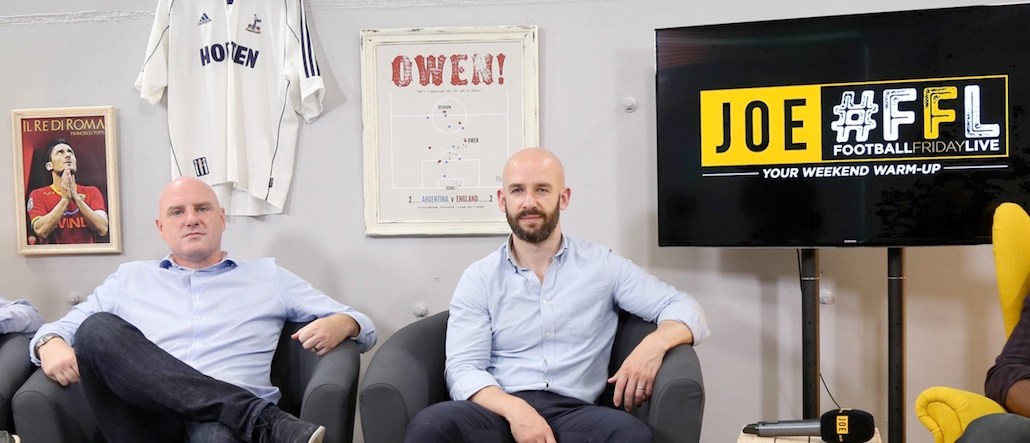Save 50% on a 3-month Digiday+ membership. Ends Dec 5.

Publishers like Joe Media are evolving their Facebook Live strategies beyond the lo-fi experimentation with blowing up fruit to something more polished and TV-like.
For the last three weeks, young-men publisher Joe Media has streamed on Facebook “Football Friday Live,” a 30-minute weekly panel discussion about the Premier League. It features former Tottenham Hotspur footballer Ledley King and Joe journalists Tony Barrett, Dion Fanning and Jim Daly. The first “Football Friday Live” Facebook Live episode has now got nearly 400,000 views, the second is nearing on 200,000. It will run up to 38 episodes.
“Football Friday Live” is much like your typical football gabfest show on TV, albeit with a more relaxed feel. The pundits are arranged on a couch and comfy chair, with a multiple-camera shoot at Joe’s studio in London. Mostly, they discuss the week’s events, everything from the games played to the players’ personal lives. Intercut with the discussion are pre-recorded segments where presenter Daly chats to fans, or play football with King.
“The main takeaway is that people get excited about live viewers,” said Joe Media CEO Will Hayward. “Others might optimize to massive viewership figures. We’re sticking to the principle of high-quality experience that people enjoy. There’s a gap in the market for quality experiences on Facebook.”
Joe Media is planning a raft of TV-like shows to live stream around lifestyle topics like fitness. The company has a 15-person video team, split between London and Ireland, which it plans to grow to 55 in the next year. The advent of live streaming on Facebook and other platforms is giving digitally native publications like Joe an opportunity to inch into programming that looks and feels a lot like TV, albeit frequently with lower production values. While Facebook looms large for distribution, other platforms are rushing into live programming.
This week Joe’s taking “Football Friday Live” to Periscope, Twitter’s live-streaming app. Twitter is pushing media companies to encourage them to use its own products for live streaming. Sky News, for example, was the first European media company partnering with Periscope to pull live streams of its political news onto Twitter too.
“Twitter is still the place that people go for real-time conversation,” said Hayward. “The nature of “FFL” is very much a live experience. Facebook gives you reach, but Twitter gives you influence.” Twitter will give Joe an assist by tweeting out the live stream from its own Twitter Sports account, which has 14 million followers. Joe Media’s sports account has just 300,000.
Viewership figures and a more polished feel are, of course, key for advertisers. Joe offers sponsorships on its live channels: Marketers can have their brands featured prominently on the show — logo placement in the opening titles, for example — but don’t have editorial control. From January, the show will have a sponsor brand for 12 months. It’s a more consistent revenue stream than creating branded content campaigns month by month, said Hayward.
By the end of this year, it plans to have 80 percent of its revenue coming from sponsored content. Currently, very little of its revenue comes from sponsored content, although Hayward declined to discuss specific figures.
More in Media

AI-powered professional learning and the battle vs. ‘workslop’: Inside Deloitte’s Scout
Deloitte last month launched Scout as part of its Project 120, the company’s $1.4 billion investment in professional development.

‘The Big Bang has happened’: Reach gets proactive on AI-era referrals, starting with subscriptions
This week, the publisher of national U.K. titles Daily Mirror, Daily Express and Daily Star, is rolling out its first paid digital subscriptions – a big departure from the free, ad-funded model it’s had throughout its 120-year history.

Arena Group, BuzzFeed, USA Today Co, Vox Media join RSL’s AI content licensing efforts
Arena Group, BuzzFeed, USA Today Co and Vox Media are participating in the RSL Collective’s efforts to license content to AI companies.





